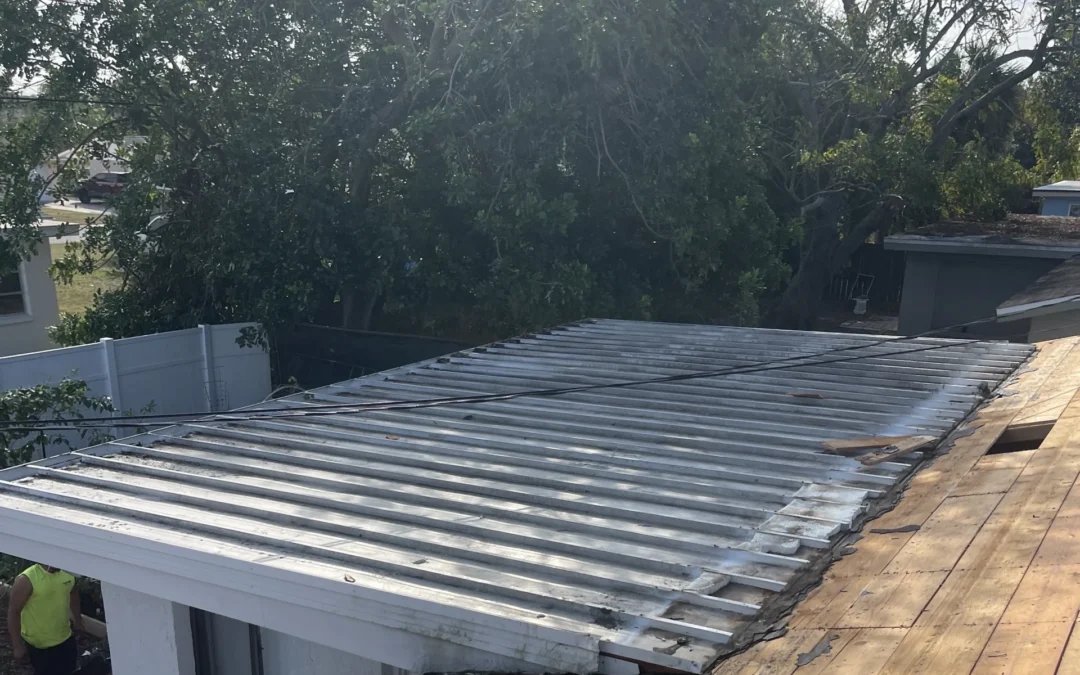Flat roofs are very popular in Florida. You see them on modern homes, apartment buildings, and commercial properties. They offer usable space and a clean, sleek look.
But flat roofs work differently than traditional pitched roofs. They have unique challenges, especially in the Tampa Bay heat and heavy rain. Because of this, staying on top of flat roofing repairs is essential.
Ignoring a small issue can lead to massive structural damage. This post will cover the most common flat roof problems. We will show you how timely fixes can save your property.
Understanding Flat Roofing Systems
Flat roofs aren’t truly flat. They have a slight slope. This slope allows water to drain toward scuppers or drains.
These roofs use different materials than shingled roofs. Common types include TPO, modified bitumen, EPDM, and rubber flat roofing. These materials form a seamless, waterproof membrane.
They must handle constant sun, standing water, and heat exposure. That’s why regular professional maintenance is key. It ensures the membrane stays intact and flexible for years.
Common Issues That Require Flat Roofing Repairs
When something goes wrong, you need a quick, targeted fix. Here’s what we see most often in Florida properties.
Standing Water and Drainage Problems
Water pooling is the enemy of a flat roof. It happens when the roof deck sags. It can also happen if drains get clogged with debris. This standing water puts enormous stress on the membrane.
The Fix: We first clean the drains and check the flow. If pooling persists, we may need to adjust the slope. Professional flat roof waterproofing methods are applied to any areas constantly underwater.
Cracks, Blisters, and Punctures
The roof membrane takes a beating from the sun and foot traffic. Over time, it can crack. Air or moisture trapped underneath can cause bubbles, called blisters. Punctures often come from dropped tools or severe hail.
The Fix: For small cracks in rubber flat roofing or TPO, we clean the area thoroughly. Then we apply a patch or specialized sealant. For serious damage or widespread blistering, a section of the membrane might need professional replacement.
Flashing Damage and Edge Separation
Flashing is the material that seals the edges. It’s found around vents, skylights, chimneys, and the roof perimeter. This is where the roof membrane transitions to a vertical surface. It is the most common place for a leak to start.
The Fix: We check the flashing frequently during inspections. If it’s pulling away or cracked, we carefully clean and re-seal it with commercial-grade sealant. If the damage is extensive, new metal flashing is installed.
Roof Membrane Shrinkage
Florida’s intense heat causes materials to expand and contract repeatedly. For some materials, this leads to membrane shrinkage over many years. This pulls on the edges and seams, which can cause them to separate and crack.
The Fix: If shrinkage is severe, simply patching won’t work long-term. This requires experienced flat roofing contractors. They will safely cut out the shrunken section and replace it with new, properly installed material.
Leaks and Moisture Damage
A leak is the result of any of the above problems. The tough part is finding the exact entry point. Water can travel a long way before it appears on your ceiling.
The Fix: Immediate action is crucial. We use thermal imaging and moisture meters to pinpoint the leak. Once located, we focus on comprehensive flat roofing repairs and re-apply top-tier flat roof waterproofing. This stops the leak and prevents secondary damage like mold.
Preventive Tips for Long-Lasting Flat Roofs
The best repair is the one you never have to make. Prevention saves you thousands in the long run.
Prioritize consistent flat roof maintenance. Schedule routine inspections at least twice a year. This is especially important before the heavy summer rain season in Tampa Bay.
Keep your roof clear of debris. Clogged drains mean standing water. Trim tree branches that hang over the roof. They can drop leaves or scrape the membrane in high winds.
Always choose professional flat roofing services over DIY attempts. Improper patching can actually trap water and make the problem worse.
Why Choose Professional Flat Roofing Contractors in Tampa Bay
Flat roofing is a specialty. You need a team with specific knowledge of these systems.
Metro Builders Tampa Bay has the local experience. We understand how Florida’s UV rays and high humidity affect every roofing material. We know which materials perform best here.
We provide precision and code compliance. Our flat roofing contractors install materials according to strict manufacturer guidelines. This preserves your warranty. We also ensure your property meets all Florida building codes. This is vital for your safety and insurance.
When you need reliable flat roofing repairs, we are your trusted local experts. You can see all our specific service offerings on our main page.
Conclusion
Taking care of your flat roof is a major investment in your property’s future. Regular inspections and timely flat roofing repairs stop small leaks from becoming huge, expensive disasters.
Don’t wait for the next major storm to find a leak. Be proactive.
Metro Builders Tampa Bay offers expert flat roofing services for all maintenance, repairs, and installations. We are the trusted local choice for your property.
Contact Metro Builders Tampa Bay today for professional flat roofing repairs and a detailed maintenance plan!
Frequently Asked Questions (FAQs)
With quality installation and regular maintenance, a modern flat roof (like TPO or EPDM) can easily last 15 to 25 years. Poor maintenance can cut that time in half.
Minor patches are okay, but most repairs need professionals. Flat roof repair is very specialized. Improperly sealed patches often fail quickly and hide bigger problems. It is always safer and smarter to call a professional.
The best method depends on the material. Often, we use liquid-applied restoration coatings. These are highly elastic and provide seamless flat roof waterproofing. They reflect heat and extend the roof’s life significantly.
You should schedule professional flat roof maintenance at least twice a year. One check should happen in the late spring, before the rainy season starts. The second should be in the late fall, after storm season ends.

Chris Price is the CEO of Metro Builders, with over 25 years of experience in construction and project leadership. He’s passionate about building strong teams, delivering quality projects, and driving innovation in the industry.



Recent Comments